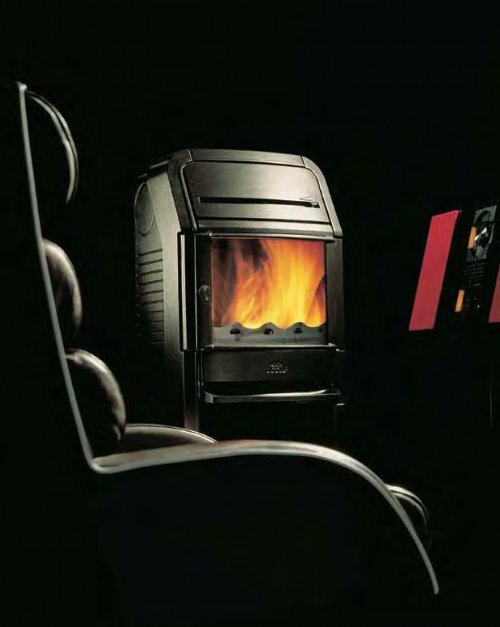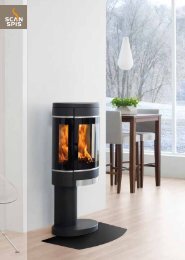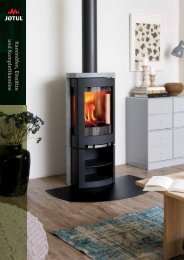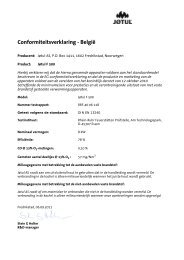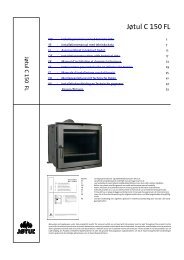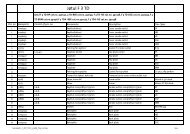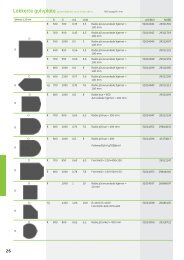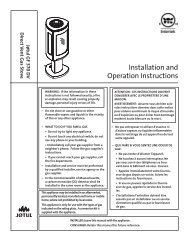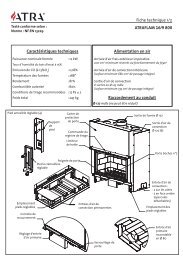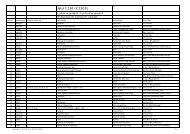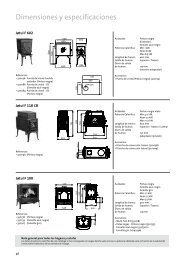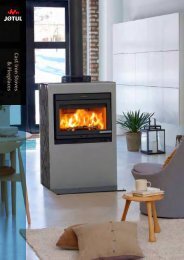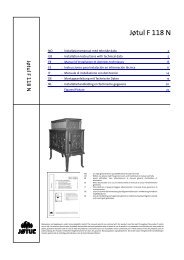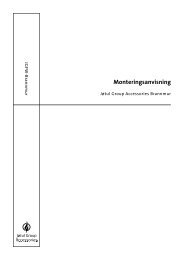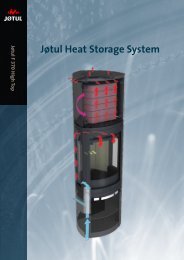Chapter 7, part 1 - Jøtul stoves and fireplaces
Chapter 7, part 1 - Jøtul stoves and fireplaces
Chapter 7, part 1 - Jøtul stoves and fireplaces
Create successful ePaper yourself
Turn your PDF publications into a flip-book with our unique Google optimized e-Paper software.
<strong>Chapter</strong> 7<br />
Reconstruction <strong>and</strong> New<br />
Expansion (1990–2003)<br />
The Jøtul Petite, today called<br />
the Jøtul F 220. The Petite heralded<br />
a new direction in Jøtul’s<br />
design line. The model was a<br />
best-seller <strong>and</strong> was important<br />
for the company’s rejuvenation<br />
in the early 1990s.<br />
Photo: Per Andersen<br />
Jøtul entered the 1990s in a state of deep crisis. As we saw in the previous chapter, in<br />
1989–90 the company suffered great losses as a result of unfortunate foreign involvements<br />
in the late 1980s. In 1990 alone, Jøtul Industries [Jøtul Industrier] operated with a<br />
loss of 99.5 million kroner. Of this, "restructuring costs", that is, losses in conjunction with writedowns<br />
<strong>and</strong> shutdown of subsidiaries, amounted to 78 million kroner. In actuality the company was<br />
bankrupt, <strong>and</strong> it was only through large transfers from the parent corporation Aker Norcem that further<br />
operation was secured.<br />
The cutbacks in foreign involvements were largely accomplished during 1990–91. After this process<br />
only the production company in Fredrikstad was left – the "actual" Jøtul. But here as well a rigorous<br />
reorganisation was needed. During 1991 the organisation was cut back to a production level that corresponded<br />
to half the capacity of the foundry. Several hundred employees were laid off, <strong>and</strong> the<br />
entire organisation was reorganised to reduce costs.<br />
The reorganisation in itself was very dem<strong>and</strong>ing. At the same time the internal turbulence left the<br />
corporation unable to mobilise the resources that were necessary to retain its position in the market.<br />
In 1990 <strong>and</strong> 1991 Jøtul lost share in all the important markets. The largest was the decline in<br />
Norway, where Jøtul’s turnover during 1990 alone dropped almost 25 per cent. Of course the total<br />
market in Norway was in recession during this period, mainly as a result of low construction activity<br />
<strong>and</strong> a general reduction in capital goods investments. But Jøtul’s decline was much more severe than<br />
the total market reduction; in other words, the company also lost considerable market share to<br />
other manufacturers.<br />
In the early 1990s Jøtul nevertheless gradually managed to resurrect itself. During 1992–93 the most<br />
dem<strong>and</strong>ing changes were completed. A more cost-effective organisation, combined with better market<br />
conditions starting in 1993, provided the basis for new growth, <strong>and</strong> in the subsequent years<br />
Reconstruction <strong>and</strong> New Expansion 205
turnover began to rise.While in the early 1990s the company had a turnover of between 210 <strong>and</strong> 220<br />
million kroner, by 1996 the turnover had climbed to almost 300 million kroner.The growth continued<br />
in the second half of the 1990s, <strong>and</strong> in 1999 the turnover reached over 425 million kroner. At the same<br />
time earnings were good. Through the entire second half of the 1990s the operation made a profit.<br />
The revitalisation of the company was based primarily on growth in Norway. Up until the middle of<br />
the 1990s, most of the marketing efforts were directed at the domestic market. In the late 1990s,<br />
however, Jøtul again began to turn its attention more actively towards the export market, <strong>and</strong> it was<br />
here that growth was strongest in the subsequent years. In 1995 Jøtul’s export share was still below<br />
50 per cent, which was considerably lower than it had been in the late 1980s. Five years later – in<br />
2000 – it had increased to well over 70 per cent, which was higher than ever before. At the start of<br />
the new millennium Jøtul was thus more export-oriented than ever before.<br />
In this chapter we shall follow Jøtul through the painful reorganisation process in the early 1990s,<br />
<strong>and</strong> on through the new period of growth that followed. We shall take a closer look at how Jøtul<br />
managed to rebuild itself after the serious blow at the start of the decade. Then we shall look more<br />
closely at the basis for the considerable growth in the second half of the decade, including the everincreasing<br />
significance the export markets once again assumed in this period.<br />
Cutbacks <strong>and</strong> reorganisation<br />
By the start of 1991, most of Jøtul’s foreign subsidiaries had been shut down or sold. The only companies<br />
Jøtul still had abroad were Jøtul AB (Sweden), Jøtul Inc (USA), Jøtul S.A. (France) <strong>and</strong> Jøtul<br />
GmbH (Germany). In addition, there were the Norwegian subsidiaries Jøtul VVS <strong>and</strong> PDS A/S. The<br />
plan was for these companies as well to be sold as soon as possible. The sole possible exception in<br />
this regard was Jøtul A.B., which was the only subsidiary that showed passable earnings.<br />
Jøtul VVS <strong>and</strong> PDS A/S were sold during the spring of 1991. The other subsidiaries were more difficult<br />
to sell. The biggest problems were with the German subsidiary – Jøtul GmbH. This company was in<br />
such a bad state that the board considered in the spring of 1991 whether to declare it bankrupt. Such<br />
a solution would produce a loss of between 11 <strong>and</strong> 15 million kroner. In the summer of the same year,<br />
however, a German company appeared, Olsberger Hutte, which wanted to buy the company. Jøtul<br />
accepted the company’s offer even though financially it provided no greater benefit than a shutdown<br />
would have produced. The sale resulted in a loss of about 10 million kroner. 368<br />
But even the companies that were reasonably solid were difficult to sell. The American subsidiary<br />
Jøtul Inc., for one, did not manage to attract interested buyers, despite the fact that the company had<br />
a passable equity capital situation <strong>and</strong> acceptable profitability. The same was true of Jøtul S.A. It was<br />
therefore decided to retain these companies for the time being, since they were not causing Jøtul<br />
any direct losses. But no future ambitions were attached to them. They would be kept running with<br />
a minimum of risk, which meant retaining the smallest possible inventories <strong>and</strong> as little administration<br />
as possible.<br />
206 Reconstruction <strong>and</strong> New Expansion
As a result of the cutbacks in the organisation it was natural to gradually dissolve the group structure.<br />
In August 1991 the operating corporation A/S Jøtul with all assets <strong>and</strong> liabilities was merged<br />
into Jøtul Industries. At the same time the corporate name was changed to Jøtul AS. The remaining<br />
subsidiaries were placed directly under the leadership of the manufacturing company.<br />
Reorganisation in Fredrikstad<br />
During 1991 the production in Norway again became the core activity in Jøtul. However, this did not<br />
mean that this <strong>part</strong> of the corporation avoided dem<strong>and</strong>s for reorganisation. Simultaneously with the<br />
cutbacks in the subsidiaries, the manufacturing company in Fredrikstad was heavily restructured.<br />
This occurred primarily during 1991.<br />
As the starting point for the restructuring of the activity in Fredrikstad, in December 1990 a so-called<br />
"zero-base budget" was worked out. In accordance with this budget, the organisation was to adopt<br />
an annual production level of 37,000 units in the coming years. This corresponded to a reduction in<br />
production of 40 per cent compared with 1989, <strong>and</strong> corresponded to barely 50 per cent utilisation of<br />
production capacity.<br />
The whole organisation was to be adapted to this level of production during 1991. This meant that a<br />
significant number of the staff would have to go. Layoffs had indeed been carried out in 1990, when<br />
the number of employees was reduced from 302 to 279. But the major cut came first in conjunction<br />
with the zero-base budget, which was structured around a base work force of 170 persons. At the<br />
same time that the budget was adopted, layoff notices were given to 110 employees.<br />
The major portion of the layoffs were in production. But the administration was slimmed down as<br />
well. For instance, the management group was cut from seven to three individuals. In future it would<br />
consist of the administrative director, who would also be responsible for the marketing de<strong>part</strong>ment,<br />
an operating director who would be responsible for operations <strong>and</strong> research <strong>and</strong> development,<br />
<strong>and</strong> finally a financial officer with responsibility for finance, personnel <strong>and</strong> IT. 369 So there would no<br />
longer be separate persons in charge of key tasks such as marketing, export, <strong>and</strong> research <strong>and</strong><br />
development work.<br />
In 1991 Vinko Janjak was hired<br />
as the new CEO of Jøtul.<br />
Janjak had a long career<br />
behind him in Norcem’s<br />
cement division.<br />
In addition, the budget required a significant cutback in all investments in plant, operations, marketing,<br />
<strong>and</strong> research <strong>and</strong> development. As the budget stated: "New organisation involves sharp reduction<br />
in the production apparatus with a transition to a single shift, reduced levels of ambition <strong>and</strong><br />
effort in the R & D de<strong>part</strong>ment <strong>and</strong> a marketing de<strong>part</strong>ment adapted to the reduced turnover". 370 In<br />
other words, the budget signalled a general reduction in the ambition level in all strategic areas. Of<br />
primary importance was to cut costs, not to rebuild the organisation with an aim to strengthen the<br />
market position.<br />
The restructuring naturally led to a sharp reduction in costs. According to the budget for 1991, the<br />
fixed costs would be reduced by 30 million kroner over the course of the operating year. In this way one<br />
would achieve "a lower risk profile than previously", as it was stated. 371 The budget operated at the<br />
same time with a net result of 8 million kroner in the black. However, this presupposed a consider-<br />
Reconstruction <strong>and</strong> New Expansion 207
able group contribution from Aker beyond the 80 million that was infused in 1990. Despite this shot<br />
in the arm, the company had lost equity in 1990, <strong>and</strong> the board calculated that the company<br />
needed an additional 40 million in group contributions to begin rebuilding its equity capital.<br />
For the employees the time of reorganisation <strong>and</strong> cutbacks was naturally extremely difficult. Many<br />
remained unemployed, enduring all the problems which that entailed. And the remaining employees<br />
lost many of their closest work colleagues. However, management instituted a close co-opera-<br />
The news that 110 men had to<br />
be laid off aroused concern in<br />
Fredrikstad. From Fredriksstad<br />
Blad [Fredrikstad News], 29<br />
November 1990.<br />
208 Reconstruction <strong>and</strong> New Expansion
tion with the workshop association in conjunction with the reorganisation. The employee representatives<br />
were included in the work of planning the zero-base budget. Furthermore, there was great<br />
underst<strong>and</strong>ing for the measures that had to be taken. The company was in crisis, <strong>and</strong> most realised<br />
that a rigorous reorganisation was crucial for further operation. Great emphasis was placed on keeping<br />
employees informed during the process. All of those who had to go were invited to meet with<br />
representatives of management, <strong>and</strong> many of those laid off were gradually rehired as production<br />
began to increase.<br />
A crossroads<br />
As we have seen, the board <strong>and</strong> administration in the first years were strongly cost-oriented.This was<br />
natural, since the primary concern was to bring the company out of the crisis. In <strong>part</strong>icular, efforts<br />
were focused on reducing the fixed costs. In this manner the company would be less vulnerable to<br />
changes in turnover. In this area the company was largely successful. Along with the group contributions<br />
from Aker the restructuring caused Jøtul by 1991 to have a profit before taxes of 18 million<br />
kroner – or 10 million more than the board had set as a goal in the budget. In the following years as<br />
well, operations showed a profit. At the same time the equity capital was rapidly rebuilt. In 1990 the<br />
board had set a goal to build an equity capital share of approximately 30 per cent over the first four<br />
years. But by 1992 the equity capital share was already 42 per cent.<br />
Financially the reconstruction proceeded quite rapidly, <strong>and</strong> by the mid-1990s Jøtul had become a<br />
rather solid company. The reconstruction was primarily based on cost cutbacks achieved by reducing<br />
investments in most areas. However, there were limits to the amount that investments could be<br />
streamlined within fundamental strategic areas such as product development <strong>and</strong> marketing<br />
efforts. The requirements for product development in the stove <strong>and</strong> fireplace market in the early<br />
1990s were presumably even tougher than before. Moreover, the competition was fiercer, making<br />
great dem<strong>and</strong>s on marketing efforts to hold on to market share. Finally, one goal was to be able to<br />
better utilise production capacity. However, this was not possible without increased exports. So Jøtul<br />
again had to start taking a more active interest in the export market.<br />
The requirements in these areas directly contradicted the requirements for minimising costs <strong>and</strong><br />
investments, <strong>and</strong> it was very important in the early 1990s to weigh these opposing needs against<br />
each other. But there was not always agreement on where the cutoff point should be. The major difference<br />
of opinion in this matter existed between the board <strong>and</strong> the administration. The board was<br />
primarily interested in keeping costs down. The administration wanted to pay more attention to<br />
rebuilding the company through a revitalisation of the product development <strong>and</strong> marketing efforts.<br />
The differences between the board <strong>and</strong> the administration in these matters were primarily related<br />
to differing ambitions. For the administration it was naturally important to build up the company’s<br />
foundation. This would primarily have to be done through an active marketing strategy, product<br />
development <strong>and</strong> the like. The owner, the Aker group, had other objectives. Aker had no industrial<br />
ambitions for Jøtul. The company did not figure in the group’s strategy for the future, <strong>and</strong> the goal<br />
was to sell it. For Aker it was therefore more important to build up solid finances as quickly as possible<br />
<strong>and</strong> not to invest in rebuilding measures that would first produce results in the long term.<br />
Reconstruction <strong>and</strong> New Expansion 209
The differences came most clearly into focus in conjunction with budget matters.The administration<br />
wanted to set ambitious goals for turnover growth <strong>and</strong> profits. In one sense there was good reason<br />
for this. As mentioned, operation at a profit occurred already in 1991, <strong>and</strong> good profits made room for<br />
greater ambitions. Despite the expectations of reduced total dem<strong>and</strong> in both markets, the administration’s<br />
proposal for the 1992 budget was based on maintaining the sales volume both domestically<br />
<strong>and</strong> abroad, at the same time that the profit goal was set at 20 million kroner.This would be achieved<br />
through a major expansion of investments in product development <strong>and</strong> marketing efforts.The board<br />
thought that the budget was far too ambitious, <strong>and</strong> it was critical of increasing investments in product<br />
development. Rather, the board wanted to reduce costs <strong>and</strong> admonished the administration to<br />
take "a sober approach in its evaluations <strong>and</strong> decisions". 372<br />
Such differences of opinion also came to light in conjunction with the preparation of the long-term<br />
plan for the period 1993–1995. 373 The administration was aiming for a growth in turnover of 20 per<br />
cent for the period. The net profits were to be improved from 20 million to 33 million kroner. These<br />
objectives, however, were based on a gradual increase in investments from 6 million (1991) to 12 million<br />
in 1994 <strong>and</strong> 1995. However, the board was sceptical of the plan. It did not want to increase the<br />
fixed costs before the turnover objectives were met. "Strong concern" was expressed about such a<br />
cost development. 374 The board wanted more concrete investment plans.<br />
As we can see, the board took a much more active position with regard to the management of the<br />
company than had been the case previously. The board exerted more influence not only by contributing<br />
to the main points in the company’s strategy, but by becoming more actively involved in<br />
most aspects of the business. In these circumstances, the difference in opinion would, by necessity,<br />
become more apparent. But the board’s changing role in Jøtul in these years is presumably only natural.<br />
It is quite common for boards to get involved more directly in operations during difficult periods.<br />
In companies that are doing well, the need is not as strong for any type of external corrective.<br />
Tore Beck was chairman of the<br />
board of Jøtul during the difficult<br />
reorganisation years.<br />
Beck was CEO of Leca,<br />
another subsidiary of<br />
the Aker Norcem group.<br />
Towards a more expansive marketing strategy<br />
Of course we should not exaggerate the differences of opinion between the board <strong>and</strong> the administration.The<br />
board also understood that Jøtul’s existence depended on such things as active marketing<br />
<strong>and</strong> product development efforts. And it was hardly due to ill intentions that the board asked<br />
questions about practically all measures that involved new costs. Rather, the board regarded this as<br />
its duty. Jøtul would not tolerate any mistakes after the problems the company had endured in<br />
recent years. And yet the board’s attitude began to change over time. Eventually, as Jøtul consolidated<br />
<strong>and</strong> grew stronger financially, the administration was also given freer rein. This was expressed<br />
both in a more active effort in product development <strong>and</strong> a more ambitious marketing strategy, first<br />
domestically, later in the export market as well.<br />
The reorganisation produces results. By 1991<br />
Dagens Næringsliv [Today’s Business] announced<br />
that the company was operating in the black.<br />
Reconstruction <strong>and</strong> New Expansion 211
The rebuilding of the domestic market started quite early. In this regard there was much catching up<br />
to do. As mentioned earlier, the total Norwegian market had declined appreciably since 1987, at the<br />
same time that Jøtul had lost market share as the result of turbulence within the company. Although<br />
in the late 1980s Jøtul had enjoyed a market share in Norway of about 70 per cent, by 1991 it had<br />
fallen to a little over 55 per cent.<br />
In the spring of 1991 the "Market Norway Improvement Project" was implemented. The objective of<br />
the project was to strengthen the sales strategies, improve the warranty <strong>and</strong> complaint system, <strong>and</strong><br />
optimise the distribution apparatus. A new incentive system aimed at the dealers also had to be set<br />
up, with rewards for dealers in the trade through bonus arrangements <strong>and</strong> the like. An effort would<br />
also be made to secure more steady order submissions over the course of the year. Key elements in<br />
this task were specifically to establish new sales <strong>and</strong> payment connections with dealers, to build up<br />
a new marketing organisation <strong>and</strong> to phase in a systematic marketing effort. 375<br />
The ambitions that served as the basis for the improvement project reveal how weakened Jøtul<br />
stood in its former primary market. The point was not to win back earlier positions, but primarily to<br />
prevent further decline. This basically defensive goal also characterised the strategy plan for the period<br />
1992–94, which was worked out in the autumn of that year. 376 Here the zero-base budget served<br />
as the blueprint, which implicitly indicated that no expansion of production was contemplated during<br />
the plan period.<br />
In the "Market Norway Improvement Project" a more active dealer policy was included. In the<br />
autumn of 1991, regional dealer meetings were held for about 140 dealers, <strong>and</strong> a total of 400 people<br />
<strong>part</strong>icipated.The goal of the meetings was to rebuild trust in the company.The dealers would be told<br />
about Jøtul’s current situation <strong>and</strong> plans for the future. In addition, the opportunity would be used<br />
to inform them about new products <strong>and</strong> ideas for further dealer co-operation. 377<br />
Of major concern was the rebuilding of the dealers’ confidence in the company. This was utterly crucial<br />
in a time when competition in the Norwegian stove <strong>and</strong> fireplace market was perhaps tougher<br />
than ever before. Several foreign manufacturers had made an active push into the Norwegian market,<br />
<strong>and</strong> some of them had gained a quite strong position. This was <strong>part</strong>icularly true of the Belgian<br />
manufacturer Dovre, which in the early 1990s had built up a market share in the Norwegian market<br />
of about 25 per cent.<br />
Moreover, the dealer structure was in the process of changing considerably, which also posed new<br />
challenges for dealer strategy. In the early 1990s the distribution of <strong>stoves</strong> <strong>and</strong> <strong>fireplaces</strong> was being<br />
transferred from dedicated heating dealers to the big chain stores, such as Norgros (Byggmaker),<br />
NKL, Løvenskiold-Vækerø (Maxbo) <strong>and</strong> others. 378 This meant that to an increasing degree was<br />
encountering dealers who because of their size could exert significant pressure on the manufacturers.<br />
The chains were less interested in establishing exclusive ties to one supplier than the heating<br />
dealers had been, but they often used the opportunity to play suppliers off against each other in<br />
order to press for lower prices <strong>and</strong> other terms. Nevertheless Jøtul did obtain an agreement with<br />
Løvenskiold in 1994 to become sole supplier of <strong>stoves</strong> <strong>and</strong> <strong>fireplaces</strong> to the corporation’s new chain.<br />
However, it was impossible to obtain such agreements with other chains. In addition, it was ques-<br />
212 Reconstruction <strong>and</strong> New Expansion
tionable whether this was even desirable. Agreements of this type had their price. The chains<br />
wanted something in return for the exclusive supplier arrangement, primarily ample discounts. Yet<br />
the chains remained the most important market channel in the 1990s.<br />
To an increasing extent, Jøtul had to resign itself to living side by side with other suppliers in the<br />
large building-supplies dealerships. In such a context it was more important than ever to be able to<br />
compete in terms of price. But even more important was to be able to deliver products that would<br />
catch the attention of consumers. It was impossible to escape a more active focus on product<br />
development.<br />
Dealer meeting in Fredrikstad.<br />
In the early 1990s dealer<br />
meetings were reinstated as a<br />
communications channel to<br />
the dealers. They had been a<br />
low priority for many years.<br />
Even though the zero-base budget from 1990 paved the way for reduced product development activity,<br />
this did not occur in practice. In 1991 the board stated that this was an area that would "take on<br />
great importance for Jøtul’s impact in future". 379 However, the board wanted to take a much more<br />
critical st<strong>and</strong> to the product development effort.The market’s desire for new product types had to be<br />
evaluated in greater depth than previously. Moreover, niche products with limited market appeal had<br />
to be withdrawn from production in order to avoid continuing small series runs with poor profitability.<br />
380 Finally, the time required for recouping investments in new products had to be reduced,<br />
although this was not explained in greater detail. 381<br />
Adaptation to new environmental requirements<br />
To a great extent, quite specific external conditions were prompting the need for new products. In<br />
the early 1990s the Norwegian authorities began to set stricter requirements for emissions in conjunction<br />
with wood burning. In 1991 new environmental regulations were announced that would<br />
also encompass emissions from home heating. There was also a growing trend to focus on the environment<br />
in a number of other countries in which Jøtul operated, especially in Sweden <strong>and</strong> the United<br />
States. This placed dem<strong>and</strong>s on Jøtul to develop emissions control technology that could be<br />
Reconstruction <strong>and</strong> New Expansion 213
adapted to both existing <strong>and</strong> new models. In Norway it was announced that new environmental regulations<br />
would go into effect on 1 January 1994. In the long-term plan for 1993–1995, which was<br />
worked out in the autumn of 1992, the goal was set to make available a complete environmental<br />
spectrum before this date.<br />
This meant that the company had a little over a year to develop emissions technology adapted to the<br />
new Norwegian requirements. Initially Jøtul stood quite well equipped to meet such a challenge. As<br />
we have seen in <strong>Chapter</strong> 6, by the early 1980s the company had already developed environmentally<br />
friendly combustion technology (the secondary combustion system). Of course there was not a large<br />
market for this technology in the 1980s, <strong>and</strong> Jøtul eventually withdrew the clean-burning models<br />
from production. But the expertise had been developed, <strong>and</strong> in this regard the company was not<br />
starting from scratch. For this reason the new environmental regulations were considered positive<br />
for Jøtul in a market context.<br />
How Jøtul’s clean-burning<br />
technology works. When the<br />
air supply to the stove is<br />
reduced using the regulator<br />
h<strong>and</strong>le at upper right, the air<br />
that passes over the glass is<br />
reduced. The combustion<br />
chamber is assured sufficient<br />
preheated air nevertheless<br />
through the holes in the vault.<br />
This air ensures complete<br />
combustion of the gases<br />
emanating from the fuel, <strong>and</strong><br />
properly balanced with the<br />
remaining air supply <strong>and</strong> the<br />
correct temperature in the<br />
combustion chamber, a visible<br />
after-burning effect is<br />
obtained under the vault.<br />
In early 1992 extensive work on further development of secondary combustion was begun. The goal<br />
was to develop new <strong>stoves</strong> with this technology before the end of 1993. In addition, all existing models<br />
were to be upgraded in order to meet these requirements. At the same time the work began on<br />
developing emissions technology for open <strong>fireplaces</strong>, <strong>and</strong> the goal was to have those ready by the<br />
autumn of 1993.<br />
The new emission requirements were delayed, however. Not until after a long period of reports <strong>and</strong><br />
hearings were the new regulations finally adopted in 1997. The regulations operated with a grace<br />
period of one year. Jøtul thus did not reap the full benefit of its advantage over foreign competitors<br />
as had been anticipated. But Jøtul already had clean-burning models in production that were largely<br />
adapted to the requirements that went into force, <strong>and</strong> this in itself was a market advantage.<br />
Towards the middle of the 1990s product development had again become a key area of focus. The<br />
activity was given more resources, <strong>and</strong> eventually it was also organisationally realigned in order to<br />
strengthen the development work. In early 1995 the technical division was reorganised with the<br />
intention of providing a better environment for product development. The division, which previously<br />
included R & D, production, logistics <strong>and</strong> operations, was divided up, <strong>and</strong> R & D became a separate<br />
area of activity. The heightened environmental requirements in Norway were an important factor<br />
behind the reorganisation. However, there were also other concerns. In the mid-1990s Jøtul was<br />
again in the process of turning its attention outwards to other markets. This too imposed significant<br />
additional dem<strong>and</strong>s on the product development work.<br />
The export market is rebuilt<br />
Even though great attention was devoted to the domestic market in the early 1990s, this did not<br />
mean that the export markets were not important from a turnover st<strong>and</strong>point. Out of a total<br />
turnover in 1992 of 43,000 units, approximately 55 per cent went to export.<br />
However, export sales in this period suffered from a lack of concentrated marketing effort. Sales were<br />
spread across numerous countries, <strong>and</strong> in many cases they occurred more or less accidentally. Out of<br />
an export in 1992 of approximately 24,000 units, 5,375 went to France, 3,086 to the United States, <strong>and</strong><br />
214 Reconstruction <strong>and</strong> New Expansion
1,688 to Germany, while the remaining 14,219 were dispersed in small numbers in many countries. A<br />
1993 report pointed out that Jøtul lacked any kind of comprehensive marketing strategy for the<br />
Spanish market, despite the fact that the company had considerable turnover in Spain. Nor were<br />
there any long-term plans for such activities. 382<br />
This fragmentation of the export turnover was unfortunate. Small volumes made it difficult to do<br />
focused marketing in individual countries, <strong>and</strong> such a marginal placement put the company in a<br />
weak position with regard to dealers. It was therefore obvious that a greater effort had to be directed<br />
at certain selected markets.<br />
It took a good while, however, before a more targeted export strategy was carved out. Naturally it<br />
was decided quite early to focus mostly on the markets in which Jøtul still had subsidiaries to take<br />
care of imports, that is, the United States, France <strong>and</strong> Sweden. But even the relationships to these<br />
countries had long been marked by considerable ambivalence. This was primarily because the markets<br />
oscillated sharply even over short periods. For example, the market in the United States <strong>and</strong><br />
France could swing from "very positive" to "moderate". This was apparently the reason why the<br />
administration struggled to decide where the most effort should be directed.<br />
From the laboratory. Here testing<br />
was done on the products’<br />
combustion, emissions <strong>and</strong><br />
heating effect.<br />
Reconstruction <strong>and</strong> New Expansion 215
In late 1994 the board emphasised "the importance of high priority for the export markets". 383 It was<br />
decided that Jøtul’s export strategy should be a central theme for the board in the coming period,<br />
including which markets, distribution forms <strong>and</strong> products on which to focus. In the board’s opinion,<br />
important factors for international growth would include charting the potential, competitive situation<br />
<strong>and</strong> marketing requirements for the various markets.<br />
In conjunction with the export effort, the board wanted the company to focus on development of<br />
market strategies rather than on product development strategies. Based on experience, however, it<br />
was difficult to ignore the product development aspect, especially if one desired concentrated<br />
growth abroad. Without products adapted to the individual markets, it was difficult to become anything<br />
more than a niche company in the specific markets. This had been well proven in France. Here<br />
the dealers had long told Jøtul that the company was lagging behind many of its competitors in<br />
terms of introducing new products. In addition, there were many dealers who did not care for Jøtul’s<br />
designs. 384 The importance of product development became evident in conjunction with the good<br />
results in France in 1993. Besides the new market strategy, the results were closely linked to the fact<br />
that at the same time a new fireplace model was launched that was specially adapted to the<br />
French market.<br />
Throughout the 1990s more<br />
emphasis was placed on developing<br />
models that were specially<br />
adapted to consumer<br />
preferences in the largest<br />
export markets. This fireplace<br />
with a so-called "guillotine<br />
door" was developed for the<br />
German market.<br />
Photo: Per Andersen<br />
216 Reconstruction <strong>and</strong> New Expansion
The alternative, therefore, was to focus on one or two major markets. In this way the company could<br />
exploit the product development capacity as efficiently as possible. At the same time emphasis had<br />
to be placed on those markets where Jøtul’s product profile was already a good match. The main<br />
focus of the export effort was determined over the next year. In a new strategy plan that was presented<br />
in the summer of 1996, it was determined that France <strong>and</strong> the United States would be the<br />
primary markets for Jøtul in the coming years. In addition, the way was paved to define Sweden <strong>and</strong><br />
Sc<strong>and</strong>inavia in general as an extension of the Norwegian market. Germany, Engl<strong>and</strong> <strong>and</strong> Italy were<br />
given the status of markets under development, but here no efforts would be made in product development<br />
or marketing campaigns. 385<br />
The United States becomes the major market<br />
It was difficult, however, to give equal attention to turnover level <strong>and</strong> product suitability. France <strong>and</strong><br />
the United States were Jøtul’s biggest markets. But they were very different when it came to product<br />
preferences. In France it was wood <strong>stoves</strong> that represented the biggest market. In the United<br />
States, on the other h<strong>and</strong>, this market was declining, while the dem<strong>and</strong> for free-st<strong>and</strong>ing <strong>fireplaces</strong><br />
was climbing. A new product area was also in the process of exp<strong>and</strong>ing in the United States: gas-<br />
Fireplace stove developed with<br />
the American market in mind.<br />
Reconstruction <strong>and</strong> New Expansion 217
fired units. In this sense these two major markets presented quite different dem<strong>and</strong>s as to shape <strong>and</strong><br />
design, <strong>and</strong> in this aspect shared few synergetic effects.<br />
The United States presented the greatest options in terms of product strategy. The main question<br />
here was how far to enter into the gas market. This was an area where Jøtul had little expertise at<br />
first. True, Jøtul Martin had produced gas-based <strong>fireplaces</strong>, but little of this expertise had remained<br />
in Jøtul after the company was sold in 1990. For a long time there was little interest in focusing on<br />
this area. For instance, Jøtul had an agreement with the Belgian company EFEL for production of a<br />
gas-based model, model 100, but this agreement was terminated in 1992. At the same time it was<br />
decided not to focus on this sector, even though it was emphasised that developments would be followed<br />
closely in this area. 386<br />
But with the focus on the United States, gas once again came to the forefront. Here both the current<br />
<strong>and</strong> the potential markets were large. In the early 1990s the annual growth rate within the gas sector<br />
had been over 30 per cent, <strong>and</strong> by the middle of the decade this sector had become utterly dominant<br />
in the United States. Of a total market in 1996 of 2.1 million units, gas accounted for 72 per cent.<br />
In the second half of the 1990s<br />
Jøtul began to focus more<br />
strongly on the American market<br />
for gas-fired units. Several<br />
gas <strong>fireplaces</strong> were then developed.<br />
In the late 1990s this<br />
market began exp<strong>and</strong>ing<br />
rapidly, <strong>and</strong> Jøtul took<br />
an active <strong>part</strong>.<br />
218 Reconstruction <strong>and</strong> New Expansion
The market for <strong>stoves</strong> <strong>and</strong> <strong>fireplaces</strong> using solid fuel, on the other h<strong>and</strong>, was in stagnation <strong>and</strong> <strong>part</strong>ial<br />
decline.<br />
Europe seemed to present a similar interest in gas, even though here wood-fired units still domiated.<br />
The American market for gas products was already large, <strong>and</strong> that alone could presumably justify an<br />
increased focus on this sector, was the thought at Jøtul. And since the interest in gas was increasing<br />
in Europe as well, a focus on gas products could also be beneficial in other markets. 387<br />
Certain efforts in this area had already been attempted. In 1992 Jøtul had begun a co-operation with<br />
the British company Stovax to produce gas <strong>stoves</strong> <strong>and</strong> <strong>fireplaces</strong>. The first practical result of this cooperation<br />
was a gas fireplace called Jøtul 3 Gas. The model was introduced in the United States in<br />
1995–96, <strong>and</strong> it was extremely well received. Jøtul therefore continued its co-operation with Stovax<br />
<strong>and</strong> at the same time began to negotiate with American companies to initiate co-operation in this<br />
area. Eventually this led to an agreement with the Superior Company for the development <strong>and</strong><br />
manufacture of gas-fired <strong>stoves</strong> <strong>and</strong> <strong>fireplaces</strong> for the American <strong>and</strong> European markets.<br />
The development <strong>and</strong> production of the new gas models was done at first at Stovax <strong>and</strong> Superior.<br />
But for Jøtul the co-operation brought with it access to valuable expertise <strong>and</strong> technology in the gas<br />
area which eventually made it possible for the company to develop gas products on its own. 388 In<br />
1996 two positions were set up at the development de<strong>part</strong>ment in Fredrikstad which would be<br />
devoted exclusively to developing gas products. The same year a co-operation was also established<br />
with Jøtul’s importer in the Benelux countries – Helex – to sell gas-based <strong>stoves</strong> <strong>and</strong> <strong>fireplaces</strong> on the<br />
European markets.<br />
In 1998 the American Bret<br />
Watson was hired as President<br />
at Jøtul Inc. in Portl<strong>and</strong>, Maine.<br />
Watson had a great deal of<br />
experience in the American<br />
stove industry, including his<br />
tenure as marketing director<br />
of Hearthstone.<br />
In the ensuing years Jøtul experienced a fairy-tale development on the American market. As early as<br />
1996 there was significant growth in turnover. From 1996 to 1997 turnover in the United States rose<br />
by 50 per cent, from 40 million kroner to 60 million kroner. The growth was primarily due to<br />
increased sales of gas products. The expansion in this area continued the next year, when turnover<br />
rose to almost 83 million kroner. And in 1999 sales virtually exploded. In that year Jøtul had turnover<br />
of about 169 million kroner in the United States, which corresponded to an increase of 104 per cent<br />
compared with the preceding year. This meant that the American market had become bigger than<br />
the Norwegian one, which that same year had a turnover of 139 million kroner. For the first time in<br />
Jøtul’s history, a single export market was bigger than the domestic market.<br />
There were basic differences between Jøtul’s first great expansion period in the United States in the<br />
latter <strong>part</strong> of the 1970s <strong>and</strong> the expansion that occurred in the latter <strong>part</strong> of the 1990s. While the<br />
expansion in the 1970s was almost exclusively dem<strong>and</strong>-driven, the one twenty years later was to a<br />
great extent the result of an active marketing strategy on Jøtul’s <strong>part</strong>.<br />
The expansion in the 1990s was largely the result of a comprehensive market adaptation built on<br />
two basic premises. First, as we have seen, the focus on the gas sector was derived directly from the<br />
desire to win market share in the United States. Second, Jøtul concentrated on adapting new products<br />
to American taste preferences. Such an adaptation to national needs was nothing new, of<br />
Reconstruction <strong>and</strong> New Expansion 219
course. But in conjunction with the effort in the United States during the 1990s, more intensive<br />
efforts were made to develop models with a specific export market in mind.<br />
It was in the American market that Jøtul made the greatest attempt to adapt its products. In 1998<br />
Jøtul established its own product development division in Portl<strong>and</strong>, Maine, U.S.A.The background for<br />
this initiative was, first, that the development de<strong>part</strong>ment in Fredrikstad could not develop new<br />
products suited to the American market fast enough. Second, it would secure greater proximity to<br />
the American market, so that both product <strong>and</strong> design development took place closer to the target<br />
market, <strong>and</strong> more in accordance with American preferences. Third, the de<strong>part</strong>ment would concentrate<br />
especially on the development of gas-based units, which had their major market in the United<br />
States.<br />
International dealer meeting in<br />
Fredrikstad. In front are CEO<br />
Vinko Janjak <strong>and</strong> export<br />
manager Gunhild Bognæs.<br />
It was Eivind Foght Lindqvist who started up the Portl<strong>and</strong> division. Lindqvist had been employed in the<br />
export de<strong>part</strong>ment at Jøtul from 1991 until the summer of 1993, when he was appointed to the position<br />
of managing director of the subsidiary in the United States. Quite soon, however, the leadership<br />
of the Portl<strong>and</strong> division was taken over by an American, Bret Watson.Watson had extensive experience<br />
in the American stove business; he had been marketing director at the big stove manufacturer,
Hearthstone. Watson also brought with him other people from his previous employer, including<br />
Shawn Malloy, who had worked with product development in the company. People were also recruited<br />
from other American manufacturers, including Vermont Castings. All in all this recruiting<br />
secured Jøtul access to valuable American expertise.<br />
The adaptation to stove <strong>and</strong> fireplace cultures of specific countries was important, as it had been for<br />
Jøtul ever since the company began operating in the export market in the 1970s. At the same time,<br />
throughout the late 1990s there was an increasing trend towards international convergence in<br />
design <strong>and</strong> shape. In this market, as in many others, there was a clear trend for the products to start<br />
looking similar. This convergence has in recent years also made it possible to develop products targeted<br />
to larger markets, or even whole regions. For Jøtul this is naturally an advantage, since there<br />
are significant benefits of scale in being able to do fewer but larger production runs. Gradually it has<br />
therefore become a basic rule in product development to design products that can be sold in as<br />
many markets as possible, while of course also leaving an option open for adaptation to special<br />
needs where deemed <strong>part</strong>icularly important. 389<br />
Growth – but how?<br />
In the mid-1990s the international stove <strong>and</strong> fireplace industry<br />
was still extremely fragmented, as it had always been.<br />
Neither in the United States nor in the European countries did<br />
any individual player dominate. It was largely only in Norway<br />
that a single manufacturer could dominate as strongly as<br />
Jøtul had. For example, there were no companies in the<br />
United States, France or Germany that had more than 10 per<br />
cent of the total market.<br />
A loyal employee leaves the<br />
table. At his de<strong>part</strong>ure in 1997,<br />
Egil Knudsen had been<br />
employed at Jøtul for 48<br />
years. He represented the old<br />
tradition, an industrial worker<br />
with a lifelong association<br />
with one company.<br />
In the mid-1990s, however, there were signs of incipient<br />
restructuring of the industry. In the United States this<br />
occurred during 1995 <strong>and</strong> 1996 with several large buyouts <strong>and</strong><br />
mergers, <strong>and</strong> it was expected that a similar trend would also<br />
take place in Europe. 390<br />
How should Jøtul h<strong>and</strong>le this development? In the spring of<br />
1997 the board discussed this question. It was clear that Jøtul<br />
could either remain passive in the face of this development or<br />
choose a more active strategy. It was thought that a passive<br />
strategy might mean that Jøtul would eventually be swallowed<br />
up by other manufacturers. In such a scenario the main<br />
question was whether the company wanted to influence who<br />
might be the potential new owner. Such a strategy, however,<br />
was not desirable. "Based on its strong br<strong>and</strong> name <strong>and</strong> well<br />
established distribution network, Jøtul has a good foundation<br />
for significant growth <strong>and</strong> wishes to assume an active role in<br />
restructuring the industry", as the board stated. 391 Reconstruction <strong>and</strong> New Expansion 221


